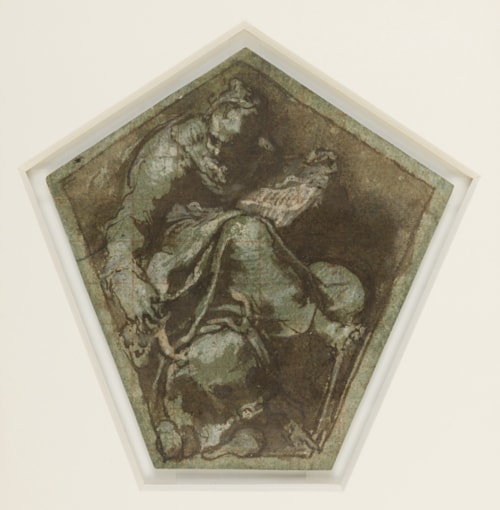
Taddeo ZUCCARO
Sant’Angelo in Vado 1529 - Rome 1566
Biography
Among the most gifted Mannerist artists working in Rome, Taddeo Zuccaro had a relatively brief career, lasting less than twenty years. He arrived in Rome at the age of fourteen and was essentially self-taught, studying the works of Raphael and his studio. Little survives of his work before 1553, and this phase of his career can only really be studied in his surviving drawings. Zuccaro’s earliest independent paintings show the particular influence of Perino del Vaga and Polidoro da Caravaggio and include several monochrome facade decorations of a type made popular by the latter, the most important of which was at the Palazzo Mattei, decorated with scenes from Roman history and completed in 1548. After a period of several months in Urbino, where he failed to complete the decoration of the choir of the Duomo left unfinished by Battista Franco, Zuccaro returned to Rome in the summer of 1553. There he immediately began work on his first major commission, the decoration of the Mattei chapel in the church of Santa Maria della Consolazione, completed in 1556. The success of this project led to a commission to paint a fresco cycle of scenes from the life of Saint Paul in the Frangipani chapel in San Marcello al Corso, on which Taddeo worked, off and on, from 1558 until his death eight years later; the work was eventually completed by his younger brother Federico. The last decade of his career also found Zuccaro enjoying the extensive patronage of the Farnese family, who commissioned from him the decoration of both the Palazzo Farnese in Rome and their vast villa at Caprarola, some sixty kilometres north of the city, with scenes illustrating the history of the Farnese. In his work of the 1560s he was often assisted by Federico, and after Taddeo’s early death at the age of thirty-seven it was his brother who completed a number of his significant commissions, notably the decoration of the Pucci Chapel in the Roman church of Santissima Trinità dei Monti. The extensive travels of Federico’s mature career also served to disseminate a somewhat diluted version of the elder Zuccaro’s style throughout Italy.
Taddeo Zuccaro was a superb draughtsman, whose drawings reveal a highly original and inventive artist. His figure studies, in particular, are drawn with a vitality and exuberance that ranks them among the most remarkable graphic statements of Roman Mannerism. Yet, as John Gere has noted, ‘though he was a draughtsman of unusual range and versatility to whom the act of drawing came naturally and who was able to express his ideas with the utmost fluency in this medium, the impression made by his drawings as a whole is that the drawing itself was never the end-product. All of them, from the rough, sometimes incoherent, pen and ink scribbles in which he noted down his thoughts as fast as they came into his head, to the sculptural studies of single figures highly wrought with the brush-point, are part of the preparatory material leading up to a painting.’ Given the scarcity of easel paintings by Taddeo Zuccaro which survive, as well as the fact that much of the large-scale decorative projects which he designed were painted by assistants, it remains through his surviving drawings that his talents are perhaps best appreciated today.


